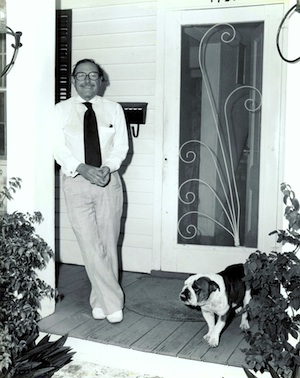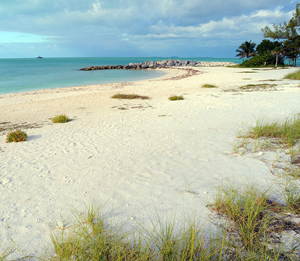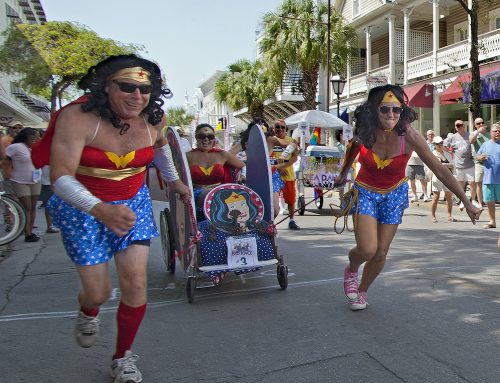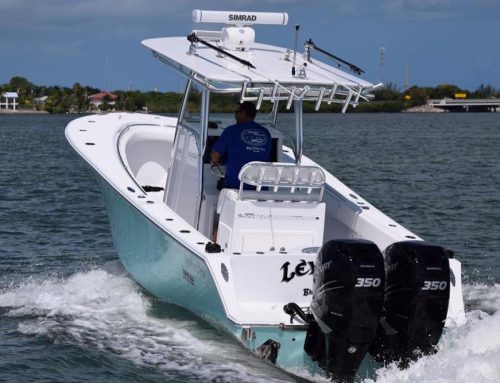Authors and artists, playwrights and poets have long been lured to the seductive island of Key West — rightfully known as one of America’s most fascinating playgrounds for creative spirits.

Tennessee Williams, one of the first gay writers to “discover” Key West, stands on the front porch of his island home. (Photo courtesy of the Ida Woodward Barron Collection, Monroe County Public Library)
In fact, the island’s laid-back atmosphere, brilliant colors of nature, year-round subtropical climate and often eccentric characters can provide constant inspiration for writers and artists.
Key West is home to many notable writers including Ann Beattie, who wrote “Chilly Scenes of Winter”; Annie Dillard, who penned “Pilgrim at Tinker Creek”; and Edmund White, winner of a Lambda Literary Award for Gay Fiction, who wrote, “A Boy’s Own Story: A Novel.”
The island sheltered the renowned gay poet James Merrill, winner of a Pulitzer Prize and two National Book Awards, until his death in 1993. Other past residents were poet-scholar John Malcolm Brinnin, who wrote “Dylan Thomas in America” and James Kirkwood, winner of the Pulitzer Prize in drama for “A Chorus Line.”
Kirkwood, by the way, once reportedly called Key West “a place for lost people who are a little tilted.”
The island’s widely varied history provides an intriguing background for writers and artists. Though Key West was once America’s wealthiest city per capita (drawing riches in part from shipwreck salvaging and cigar making), the city declared bankruptcy during the Great Depression.
To revitalize Key West and attract tourism, the Federal Emergency Relief Administration and Works Progress Administration lured writers and artists down to write guidebooks and create art. Paintings and art were hung around town and brochures, postcards and posters were sent across the country to entice visitors.
In the late 1930s Key West welcomed lesbian poet Elizabeth Bishop, who lived on White Street and wrote, painted, gardened and fished. Known for the work, “Poems: North and South — A Cold Spring,” she was a U.S. Poet Laureate and won a Pulitzer Prize and a National Book Award.

The popular beach at Fort Zachary Taylor Historic State Park is sometimes nicknamed Liz Taylor Beach. (Photo by Rob O’Neal, Florida Keys News Bureau)
Playwright Tennessee Williams arrived in 1941 and bought a house on Duncan Street eight years later. He swam, painted primitives and wrote plays including “Night of the Iguana,” “The Rose Tattoo” and “Will Mr. Merriweather Return from Memphis?”
Williams frequently entertained flamboyant friends such as Truman Capote, Gore Vidal and Carson McCullers, who helped bring national attention to the town as a mecca for gays and lesbians. Today the Key West life of the Pulitzer Prize–winning playwright is showcased in an acclaimed exhibit at 513 Truman Ave. — and a monthlong celebration in March each year.
Shakespearean scholar and playwright Philip Burton, a mentor and adoptive father to actor Richard Burton, lived on Angela Street. The actor’s wife, actress Elizabeth Taylor, visited often — thus inspiring longtime residents to dub the popular local beach at Fort Zachary Taylor State Park “Liz Taylor Beach.”
Also among Key West’s past or present resident writers are Tony Award winner Terrance McNally, known for the play “Frankie and Johnny in the Clair de Lune.” Broadway’s Jerry Herman, who produced “Hello Dolly! and “La Cage Aux Folles,” bought two identical homes on Fleming Street in the early ‘80s. His lover Marty Finkelstein lived in one.
Key West’s artistic heritage is as rich as its literary legacy. Visual artists have flocked to the island since John James Audubon visited in 1832, entranced and inspired by the ever-changing subtropical light.

Key West’s artists include mega-talented painter and public muralist Rick Worth. (Photo by Rob O’Neal)
Notable artistic residents or frequent visitors have included Mario Sanchez, famed for hand-carved and painted wooden street scenes; Ferron Bell, called Key West’s Salvador Dali; Jim Salem, renowned for his tropical landscapes; Sal Salinero, a master of trompe l’oeil; Rick Worth, who paints public murals and colorful “art cars” as well as smaller works; Steve Walker, portrayer of relationships within the gay culture; and Craig Biondi, acclaimed for tropical still lifes.
Artists’ work is displayed in fine galleries throughout the historic Old Town district. Among them is the Gingerbread Square Gallery, established in the early 1970s by the nation’s first openly gay mayor, Richard Heyman.
In the words of Nance Frank, director and curator of the respected Gallery on Greene, “Key West can be described as a big giant museum which is placed in an aquarium.” But don’t just smile at that irresistible description — come down and discover the creative island for yourself!
Click here to subscribe to the Florida Keys & Key West’s LGBT travel blog.




